While the benefits of Additive Manufacturing (AM) are starting to be more widely recognised, its unprecedented design freedom, reduced lead times, and cost-effective production, just like any emerging technology it does come with its own set of challenges. Amongst these are significant metallurgical barriers that continue to impede its further adoption by the industrial world. In this article, we will explore these barriers by providing a technical overview and how M A M Solutions can assist businesses in overcoming them, paving the way for successful AM implementation.

Overcoming Metallurgical Barriers in Additive Manufacturing: A Path to Success
1. Material Selection and Qualification:
One of the critical challenges in AM is the limited availability of qualified materials suitable for specific applications and each respective additive process. Traditional manufacturing processes have well-established material databases and qualification procedures, that include metallurgical standards and specifications which do not encompass the unique characteristics and performance found in metals produced by AM. In AM there is an intricate interplay between material properties, the process parameters, and the part design, and engineers face the task of identifying qualified materials based on factors such as thermal properties, mechanical performance, and post-processing requirements.
How M A M Solutions Can Help:
M A M Solutions offers a bespoke materials selection and qualification consulting service. With our deep understanding of materials science and extensive experience in testing materials properties and developing AM processes, we guide businesses in identifying and evaluating suitable materials for their applications. By leveraging all our knowledge of the latest advancements in AM, we enable businesses to make informed decisions and generate successful plans for the selection and qualification of materials.
2. Process Optimisation and Control:
Achieving consistent part quality in AM can be challenging due to potential for process variability and the complexity that comes with building parts layer by layer. Hence, the very nature of AM processes introduces unique microstructural features and the possible existence of defects that are all dependent on factors such as process parameters, tool path strategies, feedstock properties, and thermal management. Process optimisation and control are essential for achieving the mechanical strength, fatigue resistance, and other desired characteristics, whilst mitigating against defects like porosity, cracking due to residual stresses, and errors in form because of thermal distortion.
How M A M Solutions Can Help:
M A M Solutions collaborates closely with engineers to optimise process parameters, and post-processing techniques, including the required heat treatments to achieve the desired microstructure, resulting in tailored build strategies for the business. By selecting the right simulation tools and AM processes with real-time monitoring capabilities, we will assist in developing the quality control measures that will result in high-quality AM components.
3. Post-Processing and Heat Treatment:
Immediately following the build process metal AM parts exhibit rough surface finishes, which are not suitable for end-use applications. It is, therefore, vital to carefully consider the post-processing techniques to achieving the desired surface quality, whether for aesthetics, functionality, or compatibility with downstream processes. Additionally, surface treatments for improved corrosion resistance, wear resistance, or biocompatibility may be necessary. In the end, post-processing often accounts for more than 50% of the end-to-end production process and plays a critical role in achieving the desired mechanical properties of AM parts. This percentage can be even higher where post-processing includes any significant heat treatments.
Frequently, AM processes induce residual stresses that are inherent to the specific technique. These residual stresses can adversely affect dimensional accuracy, part integrity, and long-term reliability and are the result of either localized heating and rapid cooling, insufficient relaxation following plastic deformation, or shrinkage caused by drying mechanisms. Clearly it is most important that all heat treatment practices are carefully selected to ensure consistent mechanical properties across the entire part.
How M A M Solutions Can Help:
M A M Solutions offers expertise in post-processing, such as machining, polishing, abrasive blasting, chemical treatments. and heat treatment of AM parts. This knowledge has been founded on the early development of the requirements as metal AM first emerged onto the industrial market. Our recommendations on suitable advanced analysis, simulation, and build preparation strategies, enable businesses to optimise post-processing workflows to align with the specific requirements of the application, resulting in successful outcomes for the complete AM process chain.
4. Quality Assurance and Certification:
Ensuring consistent and repeatable quality to meet industry standards and regulatory requirements for certification are vital for the wider adoption of AM in critical applications. The slow development of standardised testing methodologies and certification procedures specific to AM poses challenges for engineers seeking regulatory compliance and customer acceptance.
How M A M Solutions Can Help:
M A M Solutions participation in international standards development organisations enables them to provide comprehensive quality assurance and certification consulting services for AM. Drawing on our extensive knowledge of the requirement for industry standards and regulations, we assist engineers in developing robust quality control processes, establishing inspection methodologies, and navigating all the certification requirements. Our aim is to ensure all AM parts meet the highest quality standards and gain regulatory approval.
Contact M A M Solutions today to unlock the possibilities of additive manufacturing while mitigating metallurgical challenges, and take a step towards a more innovative and efficient future.
